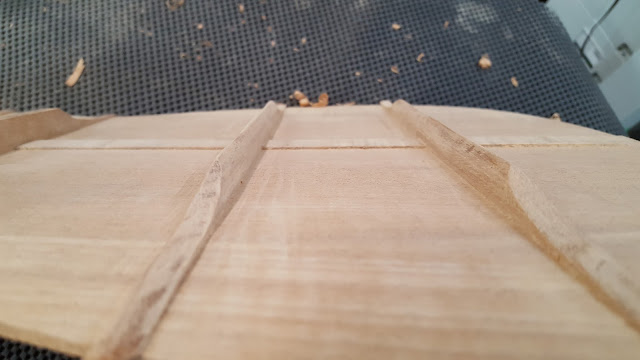The purpose of the bracing is to ensure that the very thin pieces of wood hold up over time to the string tension. Without braces, the guitar would collapse. However, too much bracing will make the plates too stiff and heavy, which will dampen the sound. Voicing the guitar is the art of placing and then selectively weakening the braces until the soundboard and back plate are strong enough to hold up over time, but weak enough to respond efficiently to string vibration.
We start by getting the braces glued up in an oversized state. Then, we shave each brace into a triangular shape (wide base, point at the top). This removes quite a bit of mass, which is good, because the lighter the plate is, the more responsive it will be. On the other hand, because we preserve the height of the brace, it remains almost as strong as it was in the first place. The best of both worlds. We get to the triangle shape using handplanes and chisels (and a bit of sandpaper). First, the back plate:

With the back plates voiced, we can glue them to the sides. We got Josh's glued up today:
Next, the soundboard. In addition to making the braces triangle-shaped, we also have to selectively weaken the bracing by shortening the braces in places where we want to make the soundboard more flexible and responsive. Here is a brace on the soundboard called a "finger brace." (Note how the end of the brace is tucked into the other brace at the end of it, which ensures the brace doesn't come unglued over time.)
Now, we'll remove material from the brace at the outer edge of the soundboard, which will make the soundboard more flexible around the perimeter. We'll also remove a lot of the material near the other brace, which will de-couple the braces and make the soundboard more flexible in this area:Finally, we'll give the brace the pyramid shape. The majority of our original material is now gone.
We repeat this process with the other braces in appropriate locations. The questions of how much material to remove, and from where, are the challenges. I'm being pretty aggressive on this guitar about making the bracing super light. It is going to be a smaller guitar, and it will be played with light strings and a lot of fingerstyle and light picking playing. So it doesn't need as much strength as it would need to hold up if it were a big guitar being played for heavy bluegrass or strumming. The lighter bracing should give the guitar very good bass response even though it is a small guitar.
To get it right, we do something called "tap tuning." That sounds fancier than it is. Basically, you hold the plate in the right spot and then tap on it in the bridge location, listening to how the frequency changes and how rapidly the sound decays. As you carve away material, the frequency drops, and the decay becomes slower. Up to a point, this is what you want.
I picked up a new tool to help with the voicing. One of the challenges voicing the guitar is holding the plate still. A company called Festool makes a really slick vacuum clamping system that I picked up Saturday, and this really makes it a lot more comfortable to carve the braces. It has a plate that forms a vacuum between the plate and the workpiece, and then you can rotate the workpiece and lock it stably in any position while you work. It's very cool.
Here is the voiced soundboard. I'll spend an hour tomorrow sanding the braces so they look pretty, although Josh and I are the only ones who will ever see them.




















































